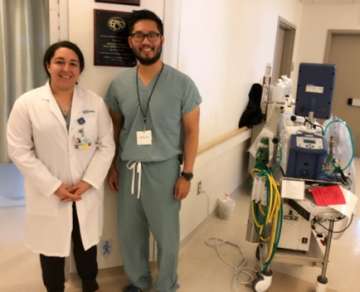About Us
Find your care
Our ECMO Program involves the expertise of multiple specialists. To learn more about our services, call 310-206-6717. To refer a patient, call 310-794-9805.
The UCLA ECMO Team
UCLA has been a leader in development and implementation of ECMO (extracorporeal membrane oxygenation) technologies over the past two decades. The ECMO team consists of doctors, including surgeons, intensivists, cardiologists and pulmonologists, as well as nurses, perfusionists, respiratory therapists, nutritionists, social workers and physical therapists. Everyone works together as a cohesive group to review the plan of care for each patient and manage the daily steps toward improvement.

The ECMO team cares for patients with around-the-clock bedside monitoring. Each patient has a dedicated nurse and perfusionist at the bedside. The team rounds daily to review labs, organ function, medication, volume management and overall patient progress. The team assesses this information and establishes goals for the days ahead. Family is encouraged to participate and ask any questions they may have.
Having perfusionists as our ECLS (extracorporeal life support) coordinators provides a level of detail and accuracy reflective of our familiarity with the specialty and our patients. These specialists are highly involved with each patient’s ECMO course. They continue to follow these patients until discharge, and complete both the national ELSO (Extracorporeal Life Support Organization) registry, as well as our internal ECMO database. We then use this data to compare ourselves to not only other similar centers, but review our own results and strive to improve as a program.
How long has ECMO been in use?
ECMO has been around for decades. The first successful use of ECMO in an adult was reported by Robert Bartlett in 1971. UCLA has vast expertise in ECMO for more than 20 years. Recent advances in cannula and pump technology have made ECMO safer and more portable allowing for its deployment in a wider group of patients.
For assistance in facilitating transfers to Ronald Reagan UCLA Medical Center, contact the UCLA Health Transfer Center at 310-825-0909